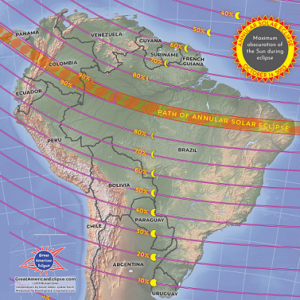
Annular eclipse: historical and mystical data
On October 14th, an annular eclipse should take place, one in which the moon leaves a small ring with southern light and settles in the center of the king star, and which has curious historical and mystical data.
take place, one in which the moon leaves a small ring with southern light and settles in the center of the king star, and which has curious historical and mystical data.
The first historically narrated eclipse, by Herodotus, describes the battle of the Medes and Lydians (590-585 BC) which ended with an agreement after they realized that the day turned into night and in their understanding the darkness should cease for peace, Herodotus describes it like this:
“In the sixth year of the war, a battle took place, and when the fighting had begun, suddenly the day turned into night. (…) The Lydians and the Medes, when they saw that the night had replaced the day, ceased their fight, anxious for peace to be established between them.” Herodotus (1.74).
Before calculating the date of the eclipse, it was believed that the battle would have been fought on September 30, 610 BC (according to William Smith’s Dictionary of the Greeks and Romans), but modern astronomical calculations have established the date as May 28 from 585 BC
The second data was established with the help of the biblical reading of the battles in Israel of Ajailon and Gibeon, which helped, according to the BBC, to reveal the date of an even earlier eclipse, at the time of the retaking of Israel by the Jews returning from Egyptian exile. , the reading that helped reveal this date, also known as Joshua’s prayer, is this (Joshua 10:12-14): “Sun, stand over Gibeon, and you, Moon, over the Valley of Aijalon”.
The BBC report, physicist Colin Humphreys, director of research at the University of Cambridge in England, and astrophysicist Graeme Waddington using this passage calculated the date of the annular eclipse and found October 30, 1207 BC.
The report also mentions that the first person to suggest such a date was the linguist Robert Wilson (1918) and that he even suggests a re-reading of the biblical text:
‘Eclipse, O Sun, in Gibeon,
And the Moon in the Valley of Aijalom´.
Since today we know that there will be a band where the eclipse is total (image) and bands next to it where the eclipse gives a partial shadow.
Heródoto, Histórias, Livro I, Clio, 74.









